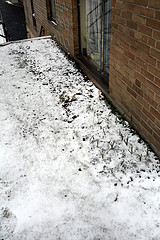Just when we thought that spring might be on its way to the Avalon, Mother Nature has thrown a fresh dose of snow at us. Despite this, it's still possible to plant outdoors. No, really!

There are a couple of different ways you could do this. If you were able to set it up in the fall, you could use a raised bed with a cold frame of glass or plastic over the top to keep the soil warm enough to germinate some cold-weather crops. However, this method is a bit space and labour intensive (though I'll probably give it a shot at the end of this year). An easier alternative is a technique called Wintersowing. It follows some similar principles as seed starting indoors, but instead of keeping the seeds and plants inside under artificial lights, the idea is to plant seeds of things that can at least tolerate some cold.
Here's a list of what you'll need:
A container: Most of us have at least a few clear plastic containers around, and since some of them can't go in the recycling program yet, that's your best bet. 2 litre bottles in particular should work well, as they've got a built-in vent (the cap). You should stick to things that have a clear or translucent top.
Seed starting mix: If you've started some seeds indoors, you've probably got at least a bit left around from your last project.
Something sharp: Most containers will need to have some holes punched in them, so you'll need something sharp like a knife. If you're using 2 litre bottles, you'll need to cut them in half.
Tape: If the container you're using is intact, like a 2 litre bottle, then you'll need some tape to attach the top again.
Seeds: You should stick to varieties that are cold-hardy. Beets, spinach, and even some lettuces should do ok.
Patience: Seeds that are germinated in this way are still going to be colder than they would be if you were starting them later in the season, so don't be shocked if it takes a lot longer to germinate.
Once you've got everything gathered up, it's time to start planting! Take your container, and poke a few holes in the bottom for drainage. Then poke a few holes in the top of the container (If you're using something which already has one or more holes in the top, you can skip that). Add your planting material, then plant your seeds as if you were starting them indoors. Water the seeds, close the container, and place in a sunny spot outdoors. It definitely helps if your spot faces South, because you'll likely get all-day sun. My backyard faces East, so I get morning sun, but that should still be sufficient. If your spot outside doesn't get much/any sunlight, this may not work as well, as you need some light to get the heat up inside the container.
This idea might seem a bit crazy at first, but considering that the average low temperature for March is only -6.2 degrees, and that we should be able to get at least 10-15 degrees warmer inside the container during the day, it could be a really excellent way to get an early start on your planting.
You can find out more about wintersowing techniques, as well as what has been tested in the past by going to www.wintersown.org.

